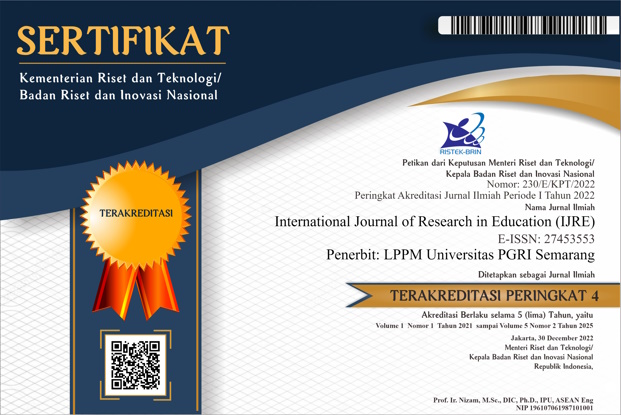Implementation of Blue Ocean Strategy (BOS) at the Opening of the UNINDRA PGRI Digital Business Department
DOI:
https://doi.org/10.26877/ijre.v4i2.455Keywords:
Blue Ocean Strategy, Implementation, Business Digital DepartmentAbstract
The decreasing number of student admissions, especially when the Covid-19 pandemic hit and the increasing number of universities in Jakarta, the competition is getting tighter. For this reason, implementing the Blue Ocean Strategy by opening a Digital Business major is the right way to get out of the competition and find new, unexplored opportunities and markets. The aim of this research is to describe the process of implementing BOS at the opening of the Digital Business major. The method used in this research is a qualitative approach using interviews, observation and documentation studies as data collection techniques. The research results show that the formulation of the blue ocean strategy is going well, especially the decision to open a Digital Business major through the stages of market boundary reconstruction, ERRC scheme, 3 non-consumer levels and strategic series. This is proven by the number of students who choose this major amounting to approximately 300 people with a class size of 10. Relevant curriculum development, industrial collaboration, use of technology in learning, lecturer training and effective promotion are suggestions that should be considered for the success of this implementation in long-term
References
Altbach, P. G., Reisberg, L., & Rumbley, L. E. (2019). Trends in Global Higher Education. In Trends in Global Higher Education. https://doi.org/10.1163/9789004406155
Dehkordi, G., Rezvani, S., & Behravan, N. (2012). Blue Ocean Strategy: A Study Over A Strategy Which Help The Firm To Survive From Competitive Environment. International Journal of Academic Research in Business and Social Sciences, 2(6), 477–484. http://www.doaj.org/doaj?func=fulltext&aId=1144785
Jones, A. (2020). The Impact of Technology on Student Career Choices. Journal of Educational Technology, 45(2), 134–150.
Kartajaya, H., & Ridwansyah, A. (2014). WOW Selling: Salespeople Are the Real Marketeers.
Kim, C., & Mauborgne, R. (2009). Blue Ocean Strategy (Strategi Samudra Biru) : Ciptakan Ruang Pasar Tanpa Pesaing dan Biarkan Kompetisi Tak Lagi Relevan. Serambi Ilmu Semesta.
Kim, C., & Mauborgne, R. (2015). Red ocean traps. Harvard Business Review, 68–73.
Kim, W. C., & Mauborgne, R. (2005). How to create uncontested market space and make the competition irrelevant. Harv Bus Rev, 4, 13. http://strategiccompliancegroup.com/docs/BOS.pdf%0Ahttps://hbr.org/2004/10/blue-ocean-strategy
Lailasari, I. (2022). Strategi penerimaan peserta didik baru (ppdb) smpit ibnu khaldun panambangan dengan menggunakan blue ocean strategy. Jurnal Impresi Indonesia, 1(1), 1–6.
Lismawati, & Amaliyah, L. N. (2023). Peran Blue Ocean Strategy Dalam Manajemen Pendidikan. Jurnal Ilmiah Multidisiplin, 2(2), 453–461.
Lukman, B. W. (2012). Value inovation. 1–5.
McAuley, J., Pandey, R., & Leskovec, J. (2015). Inferring networks of substitutable and complementary products. Proceedings of the ACM SIGKDD International Conference on Knowledge Discovery and Data Mining, 2015-August, 785–794. https://doi.org/10.1145/2783258.2783381
Mulyasana, D. (2008). Pendidikan Dalam Spektrum Blue Ocean Strategies Dalam Tatakelola Pendidikan Berdaya Saing Di Tengah Kompleksitas Perubahan. Universitas Islam Nusantara.
Nilamsari, N. (2014). Memahami Studi Dokumen Dalam Penelitian Kualitatif. Wacana, 8(2), 177–1828. http://fisip.untirta.ac.id/teguh/?p=16/
Nur, M., Wilopo, I., & Kholid Mawardi, M. (2016). IMPLEMENTASI BLUE OCEAN STRATEGY PADA AMSTIRDAM COFFEE (Studi Kasus pada CV. Pemenang Sejati Kabupaten Malang). Jurnal Administrasi Bisnis (JAB)|Vol, 41(1), 72–81.
Radius. (2021, September 7). Perguruan Tinggi Swasta Terancam Bangkrut. https://www.getradius.id/news/87945-perguruan-tinggi-swasta-terancan-bangkrut
Sije, A., & Oloko, M. (2013). Penetration pricing strategy and performance of small and medium enterprises in kenya. European Journal of Business and Social Sciences, 2(9), 114–123. http://www.ejbss.com/recent.aspx
Smith, J. (2019). Shaping the Future: The Role of Technology in Influencing College Major Selection. Journal of Higher Education, 36(4), 567–584.
Solikhin, M., & Email, I. (2019). http://e-journal.ikhac.ac.id/index.php/nidhomulhaq.
Suhendi, S. (2022). Implementasi Blue Ocean Strategy (BOS) dalam Pemasaran STIE Miftahul Huda. Jurnal Pendidikan Tambusai, 6(1), 1528–1538.
Suyanto, S., & Rosfadhila, M. E. (2017). Strategic Management and Performance of Private Higher Education Institutions: The Mediating Role of Competitive Advantage. International Journal of Educational Management, 31(5), 621–637. https://doi.org/doi:10.1108/IJEM-08-2015-0109.
Tobari. (2015). Strategi Perguruan Tinggi Swasta Menghadapi Persaingan. Jurnal Media Wahana Ekonomika, 12, 61–68.
Unindra. (2016). Laporan Kinerja Unindra 2016.
Unindra. (2017). Laporan Kinerja Unindra 2017.
Unindra. (2018). Laporan Kinerja 2018.
Unindra. (2019). Laporan Kinerja Unindra 2019.
Utama, C. (2008). Menjalankan rangkaian strategis samudra biru (suatu ide penerapan di perguruan tinggi). Majalah Ilmiah Fakultas Ekonomi UNPAR, 12(2005), 44–54.
Yusuf, A. M. (2016). Metode penelitian kuantitatif, kualitatif & penelitian gabungan. Prenada Media.



